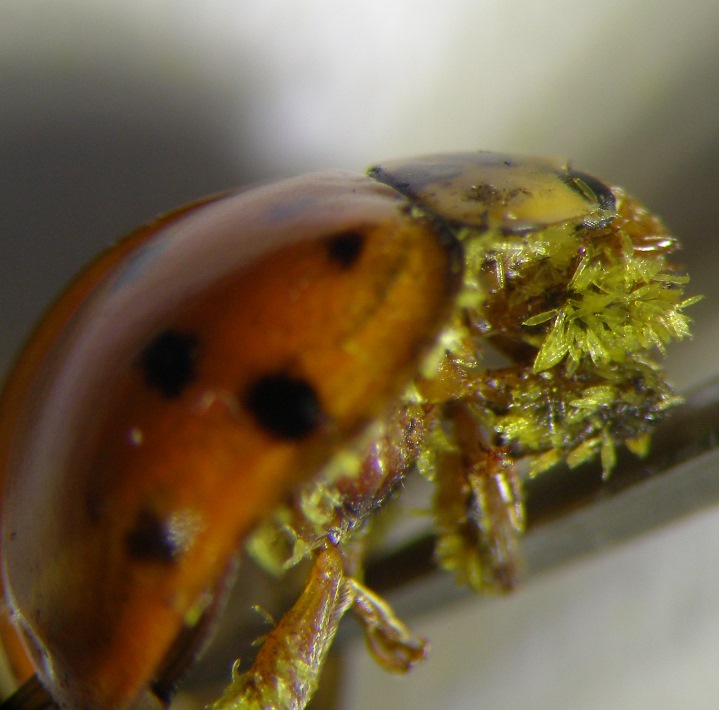Call for public action as sexually transmitted fungal epidemic hits the invasive harlequin ladybird
Back to news

Scientists are calling for public support as they seek to map the spread of a sexually transmitted fungal epidemic, recently found within populations of the invasive harlequin ladybird in the UK.
Native UK ladybirds have suffered dramatic declines in numbers since the notorious harlequin ladybird (Harmonia axyridis) made its way to the UK ten years ago.
Now an insect fungus, transmitted primarily during mating, has been found infecting the spotted invader.
University of Stirling researchers Katie Murray and Matt Tinsley are working in partnership with Helen Roy at the Centre for Ecology & Hydrology to survey the sharp rise of the Laboulbeniales fungal infection in the invasive harlequin.
This summer, Katie Murray found the fungus in London infecting a much higher proportion of harlequin ladybirds than had been previously seen. The researchers are now asking for help from the public to track the disease by looking for ladybirds in their houses, sheds or in leaf litter and completing an online survey launched today.
Records from the public will allow researchers to look at the extent and spread-rate of the epidemic. Previous studies have found the infection in a different species, the native 2-spot ladybird, particularly in London.
Katie Murray said: “The cold conditions at this time of year mean ladybirds huddle together in leaf litter or other sheltered places like houses, sheds, garages, or other outbuildings.
“Checking for these groups of ladybirds is a good way to have a look for the fungus, which leaves little yellow bristles growing on their bodies. Many ladybirds will have only a few of the bristles, so people will have to look carefully.”
Matt Tinsley said: “The study will allow us to know where this fungus has spread to and what proportion of native and invasive ladybirds are infected. This will contribute to ongoing research into the effects of parasites on this invasive alien ladybird.”
Intrepid ladybird spotters are encouraged to submit photographs, count how many ladybirds they spot and how many appear to have the infection.
The study will be added to the existing UK Ladybird Survey to help understand the effects of the fungus and the continued problems caused by the harlequin.
Helen Roy, ecologist at the Centre for Ecology & Hydrology in Oxfordshire and coordinator of the UK Ladybird Survey, said: “People across the UK have been instrumental in tracking the spread of the harlequin ladybird and providing records of native ladybirds too.
“Through the inspiring contributions of citizen scientists we have hugely increased our understanding of the ecology of ladybirds in Britain. There is now a unique and exciting opportunity to monitor the spread of this intriguing fungus alongside the spread of the harlequin ladybird.”
To complete the survey, visit: http://www.brc.ac.uk/irecord/enter-Hesperomyces-records
Notes for editors
- Background information
- For further details visit: http://www.ladybird-survey.org/laboulbeniales.aspx or follow the study on twitter @katiemurray88, #ladybirdSTD
- More information on the harlequin ladybird can be found on the UK Ladybird Survey website http://www.ladybird-survey.org/harlequin.aspx including an animated map showing the spread of the harlequin across the UK from 2003 http://www.ladybird-survey.org/harlequin_spread_UK.aspx
- The harlequin is an invasive non-native species in the UK. An alert system operates within the UK for invasive species and the latest species alerts can be found here http://www.nonnativespecies.org/alerts/index.cfm. In recent weeks another new invasive to the UK, the quagga mussel, has been recorded for the first time. Sightings of harlequin ladybirds, quagga mussels and other non-native species should be reported via the iRecord system http://www.brc.ac.uk/irecord/enter-non-native-records
- Stirling University division of Biological & Environmental Sciences undertakes research to understand the fundamental processes driving the evolution and maintenance of biodiversity from the genetic to the ecosystem level, and to predict and mitigate perturbations result from environmental changes, from local to global scales. The on-going and long-term goal for our research is to ensure a sustainable, healthy future for humanity and the environments on which we depend. From fundamental process-based studies we develop and test policy and management solutions to give new approaches to natural resource management, mitigate or reverse the impacts of human activities on biodiversity, environmental services and natural resources. https://www.stir.ac.uk/natural-sciences/research/groups/bes/
- The Centre for Ecology & Hydrology (CEH) is the UK's Centre of Excellence for integrated research in the land and freshwater ecosystems and their interaction with the atmosphere. CEH is part of the Natural Environment Research Council (NERC), employs more than 450 people at four major sites in England, Scotland and Wales, hosts over 150 PhD students, and has an overall budget of about £35m. CEH tackles complex environmental challenges to deliver practicable solutions so that future generations can benefit from a rich and healthy environment. www.ceh.ac.uk You can follow the latest developments in CEH research via twitter www.twitter.com/CEHScienceNews and our rss news feed http://www.ceh.ac.uk/rss/rss.xml
- NERC is the UK's main agency for funding and managing world-class research, training and knowledge exchange in the environmental sciences. It coordinates some of the world's most exciting research projects, tackling major issues such as climate change, food security, environmental influences on human health, the genetic make-up of life on earth, and much more. NERC receives around £300m a year from the government's science budget, which it uses to fund research and training in universities and its own research centres. www.nerc.ac.uk
